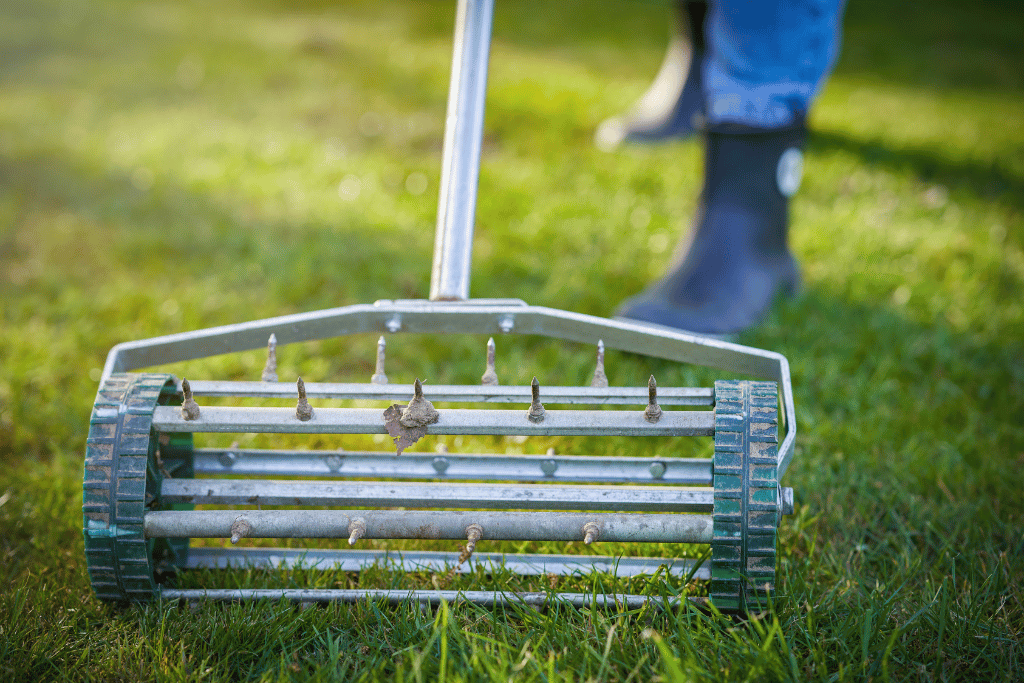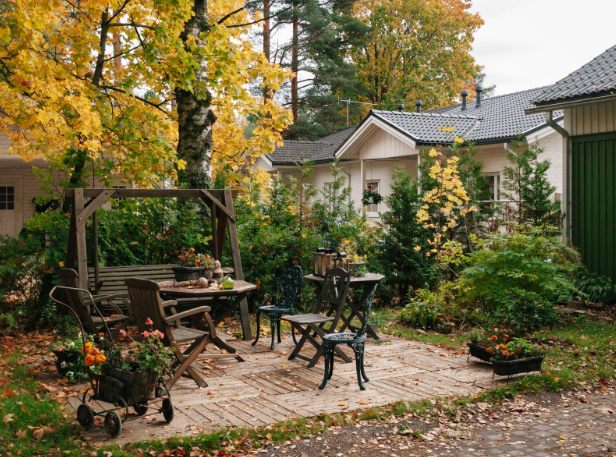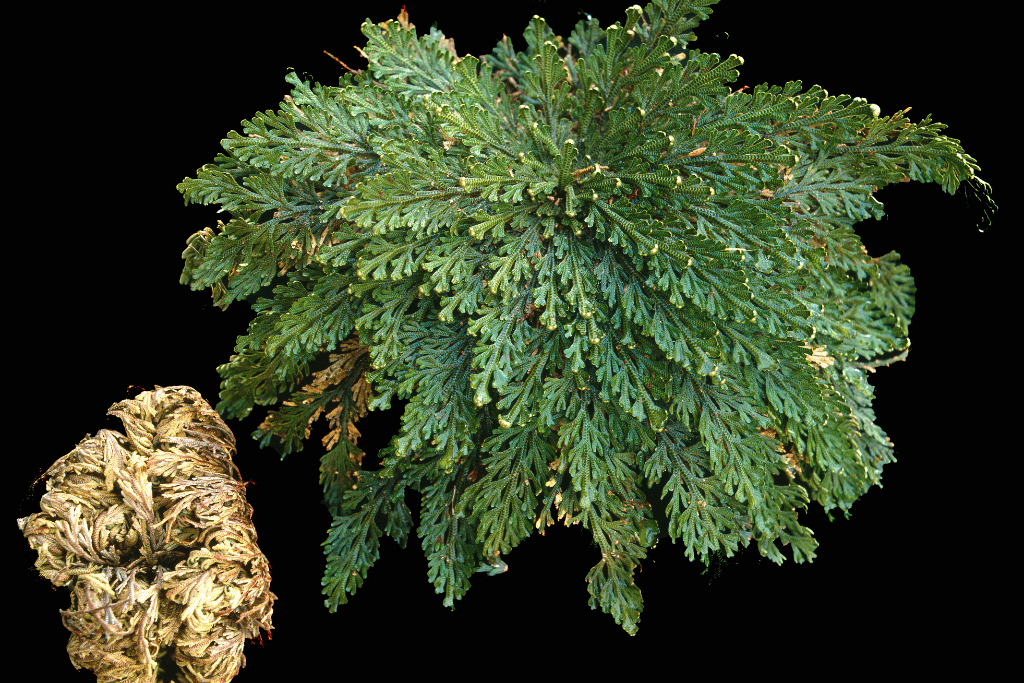
The Rose of Jericho is certainly a one-of-a-kind plant.
In this article, we’ll be discussing Selaginella lepidophylla, the “false” rose of Jericho, as it is more widely known and popularly kept as a houseplant. Anastatica hierochuntica is known as the “true” rose of Jericho, originating in the Middle East and western Asia.
This curious plant goes by many common names including false rose of Jericho, rose of Jericho, resurrection plant, flower of stone, dinosaur plant, resurrection moss, stone flower, siempre viva (forever alive) and doradilla.
Rose of Jericho grows natively in the Chihuahuan Desert of Northern Mexico and the Southwestern United States. It grows to a diminutive overall height of just around 2 inches. The most unique characteristic of this desert plant is its ability to be desiccated, then rehydrated and resume its normal plant processes.
To withstand the harsh arid climates of the desert, rose of Jericho curls its stems inwards into a ball shape as it dries out. The plant “resurrects” and the leaves once again unfurl when it receives water. The fact that it is truly able to resurrect after being completely dried out is a remarkable feat. One that is almost unheard of in the plant world.
History
The plant is believed to an ancient survivor, a holdover from previous prehistoric eras. Selaginella lepidophylla, native to Mexico, New Mexico and Arizona is a fern relative and is technically considered a spike moss. It has been referenced throughout history in literature and religious and spiritual folklore.
Many families of the region keep the plant and pass it down to future generations as a memento and symbol of heritage and perseverance.
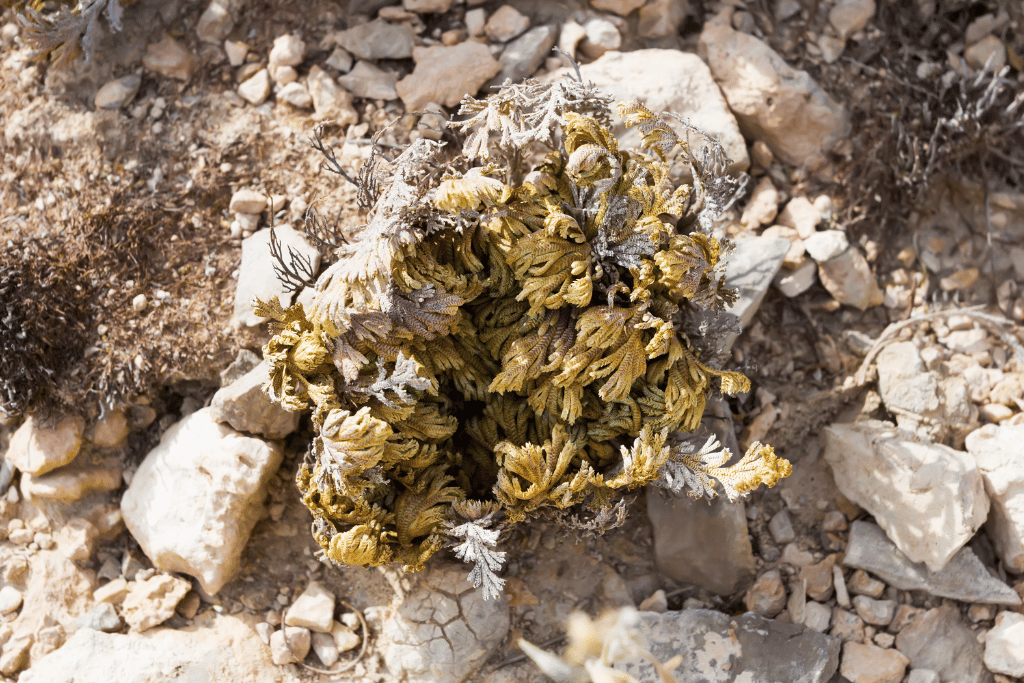
Symbolic Significance and Spiritual Use
An interesting parallel can be drawn from this humble, itinerant plant to the Christian faith. The plant that is able to wander, survive on meager subsistence and appear to rise from the dead is an appropriate symbolic representation of the holiest celebration of Easter. The connection to the death and resurrection of Christ is clear and the plant is often given as a gift around Easter time as well as Christmas.
For the Spanish missionaries that reached the desert regions of northern Mexico and the Southwestern US, the rose of Jericho was the perfect icon to point to. It demonstrated the idea of abandoning one belief and culture and being reborn into a new faith. The name Jericho is another direct biblical reference.
It’s significant in other spiritual belief systems as well, such as some forms of voodoo and santeria. Rose of Jericho is thought to bring about or “resurrect” love and good luck in one’s life. It is also believed to draw bad energy out of the body when worn as an accessory.
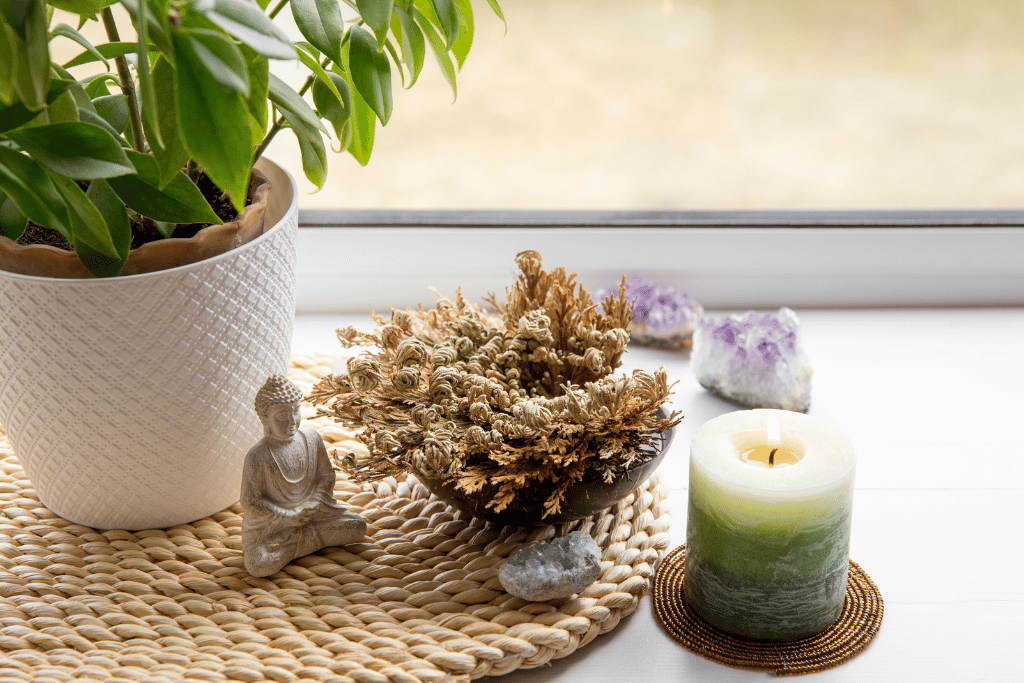
Health Benefits
Please don’t construe any of these claims as medical advice, I’m merely reporting how and why the plant has traditionally been used.
- As an herbal tea, it’s reported that rose of Jericho can soothe the symptoms of cold, flu and sore throats.
- It has also been used as a diuretic to help detoxify and flush out the kidneys.
- Additionally, rose of Jericho is used to treat arthritis, inflammation, cramps and menstrual pain.
Distinct Features
Selaginella lepidophylla is one of the strangest plants out there, which makes it such a fun and interesting plant to grow.
- Rose of Jericho is a lycophyte, a class of plants related to ferns.
- Their leaves resemble fern leaves and they reproduce asexually by sending out spores.
- Rose of Jericho can survive up to seven years without water by drying out and curling up into a ball.
- They can lose 95% of their moisture without experiencing cell or tissue damage.
- Dormant, desiccated (dried out) resurrection plants turn into tumbleweeds and blow around the desert in search of moisture.
- Within just a few hours of exposure to moisture, a completely desiccated plant will open up and begin to turn green again.
- Rose of Jericho adapts well to being grown as a houseplant.
Growth Habit
Rose of Jericho doesn’t have roots as we typically envision them. Instead, it has a complex network of lignified cells throughout its distinct foliage that dictates moisture absorption and transport.
After periods of drought, typical in its native desert environment, the outer stems begin to curl inwards into tight rings. The inner stems then follow suit, slowly spiraling in as the stems stiffen up from being dried out.
Rose of Jericho remains shrubby in stature and will only grow to 2 inches tall at its maximum height.
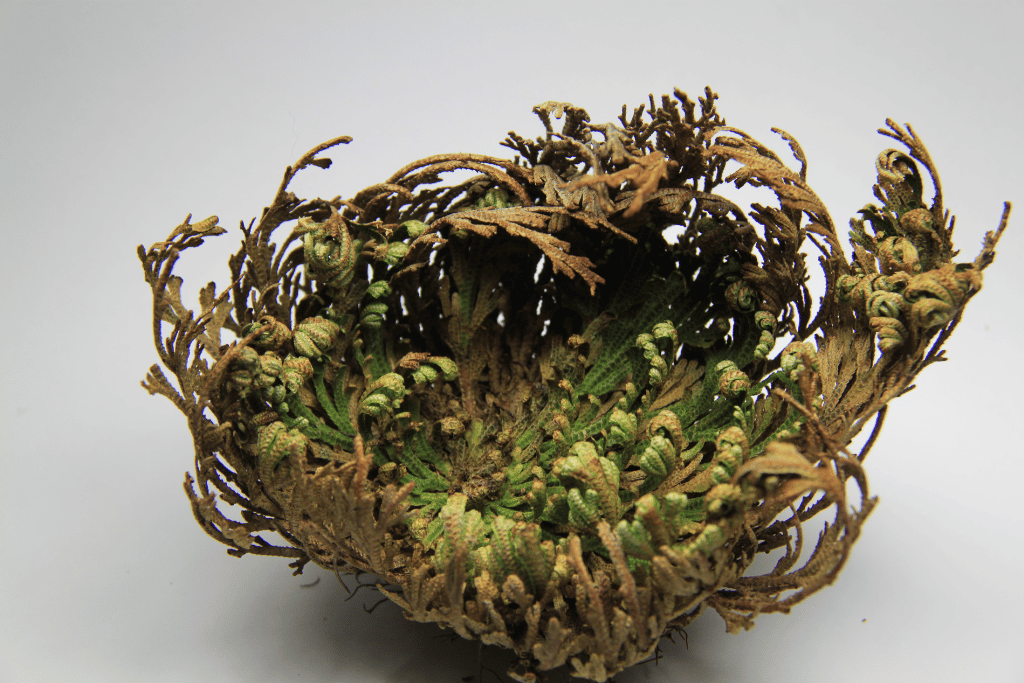
Conditions
Being acclimated to some of the harshest conditions on earth rose of Jericho will tolerate just about any environment you put it in!
But there are plenty of ways you can make a more comfortable home for your resurrection plant. It will repay you with interesting green foliage for years to come.
Soil
Rose of Jericho doesn’t even need to be planted in soil to stay alive. All you have to do is fill a bowl with pebbles and cover them with water. Place your plant in the bowl and let it dry out from time to time to be sure it’s not constantly sitting in moisture.
On the other hand, after you rehydrate your rose of Jericho, you can plant it just like any other potted plant. A well-drained container and soil will be the most important factor.
The formula for making the best indoor potting mix is
- Two parts organic matter (soil, compost, worm castings, humus)
- One part drainage (perlite, vermiculite, coarse sand, rice hulls)
- One part water retention (peat moss, coco coir)
The organic content will add substance holding the mix together. It will also slowly break down and feed your plant over time.
The drainage elements will keep the media from sticking together, allowing water and oxygen to pass through freely.
The moisture retention ingredients will ensure that your roots don’t easily dry out. Coco coir and peat moss both absorb water well but also keep their light and airy consistency.
Light
You’ll want to replicate your resurrection plant’s native habitat, so be sure to give it plenty of light. The bright, indirect light of a south or west-facing window will provide the perfect growing conditions.
You might think that direct sunlight is a good idea, I mean rose of Jericho comes from the desert right?
Well yes, and no.
Intense direct sunshine will dry out your plant quickly, causing it to grow unevenly and struggle to maintain its intriguing green foliage. Plus, the intense rays of the sun may be too much for the plant to withstand now that it has adapted to indoor living.
The best compromise is to make sure it is always in a bright place but out of direct light.
Temperature and Humidity
The same principle stands true for atmospheric conditions. Your resurrection plant acclimates quickly to comfortable temperatures and humidity levels. It won’t tolerate drastic changes in its environment. Don’t expose it to extremely cold or hot temperatures.
A steady temperature within 65-85 degrees is the perfect range to shoot for. But remember the less variation in temperature the better.
Keep your rose of Jericho plant away from heating units or drafty doors or windows to prevent exposure to wildly fluctuating microclimates.
Humidity shouldn’t be much of a problem for rose of Jericho. Since it is kept in a bowl of pebbles and water, the surrounding humidity levels should be quite high. If you have it planted in soil and are concerned about overwatering, consider making a pebble tray.
Add pebbles or small stones to a saucer or planting tray and fill it with water. Set the container on top of the pebbles, so the tray will catch the runoff from watering. It will eventually evaporate, keeping the environment humid and comfortable without the need for constant watering.
Care and Maintenance
Rose of Jericho is a plant that requires minimal attention and care. It’s self-sufficient for the most part and you can expect the plant to forever remain happy and healthy when you establish a care routine that suits its needs.
Water
The quality of water is one of the few aspects of care that resurrection plants are picky about. Do your best to use purified, distilled or otherwise untreated forms of water.
You’ll most likely purchase your rose of Jericho as a desiccated curled-up ball of fronds that will need to be rehydrated. Fill an adequately sized dish (it doesn’t have to be large by any means, as rose of Jericho will not grow to a large size even in a bigger container) with pebbles and pour in clean water. Bring the water level to just above the surface of the pebbles so the plant can rest on top without sitting in a puddle.
Even in the shallows of the pebble container rose of Jericho will contract mold and rot if it’s constantly wet. Make sure to give your plant at least one dry day per week to let it wick off any excess moisture that it has collected.
If growing your rose of Jericho in a container and potting mix make sure it drains extremely well. Water sparingly, only when the mix is almost completely dried out. Water well when it is time to do so, but like with the pebbles, never let the rose of Jericho sit in a pool of water.
Watch in amazement as you can physically observe the plant begin to absorb water, unfold its fronds and start to green up. The entire plant will be completely rejuvenated within a couple of days. You won’t believe your eyes when you see this ragged tumbleweed transform into a lush, green fern-like shrub.
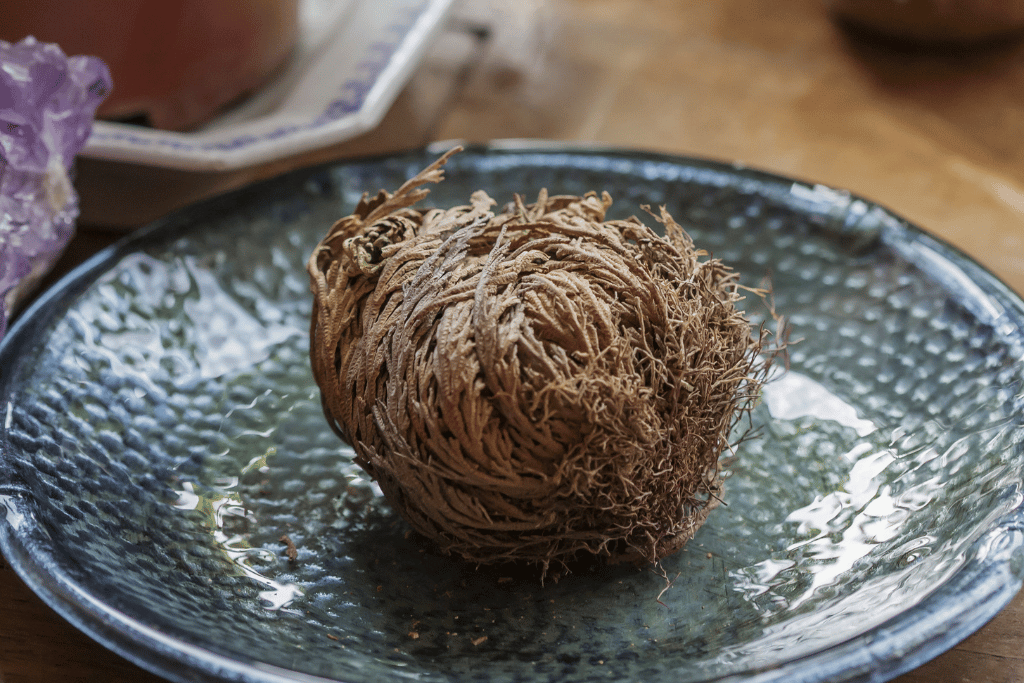
Fertilizer
The rugged and resilient plant requires little to no fertilizing because it’s so used to finding scarce nutrients in its native environment. Less fertilizer is better than more when it comes to feeding your rose of Jericho.
Incredibly, feeding once or twice per year is enough to satiate a resurrection plant. The first thing in the spring is a good time to feed. One more time during the active growing season, around midsummer, will give it a boost of nutrients that lasts the rest of the year.
A water-soluble fish emulsion or liquid seaweed feed are healthy, all-natural options. Dilute the fertilizer to a feeble strength, about 10% of the instructed dose.

Pruning
Trimming and pruning are almost nonexistent chores when it comes to your rose of Jericho. Use a small pair of sterilized shears to snip off any dead fronds or burnt tips that don’t rehydrate.
Propagation
Rose of Jericho can be easily propagated by division. As a sporophyte, it does not produce flowers or seeds and thereby is unable to propagate via sexual reproduction. It’s not exactly practical, or possible, to propagate rose of Jericho through spore production.
The best time to take a cutting is in the spring or late fall as the plant is going dormant.
- Take a cutting that is the entirety of one whole frond.
- Set the cutting on some tiny pebbles, coarse sand or loose soil, mist well and keep it moist.
- Within a few days the new cutting should be showing some signs of life.
- Then, treat the cutting as you would a mature plant. Put it into another container with pebbles or plant it in well-draining soil.
The process of propagating a rose of Jericho is as simple as it gets. In a matter of no time you could be the proud new owner of handfuls of new plants that make great gifts around Easter or the Spring Equinox and are easy to sell at farmer’s markets, craft fairs or online.
Overwintering
Rose of Jericho will only need special winter attention if you grow it outdoors. It really can’t stand extreme cold, so it ought to be taken indoors for the cold months.
Put it in a paper box or bag and set it in a dry place that’s out of the way. Your rose of Jericho plant will continue to dry out and you can anticipate its triumphant revival in the spring.
Where to Find
Since rose of Jericho is resilient and easy to store, desiccated forms of the plant are widely available online. Popular online retailers like Amazon and Etsy have large selections. It’s available many other places as well. All you have to do is order it up, wait for its arrival and rehydrate as detailed in this article.
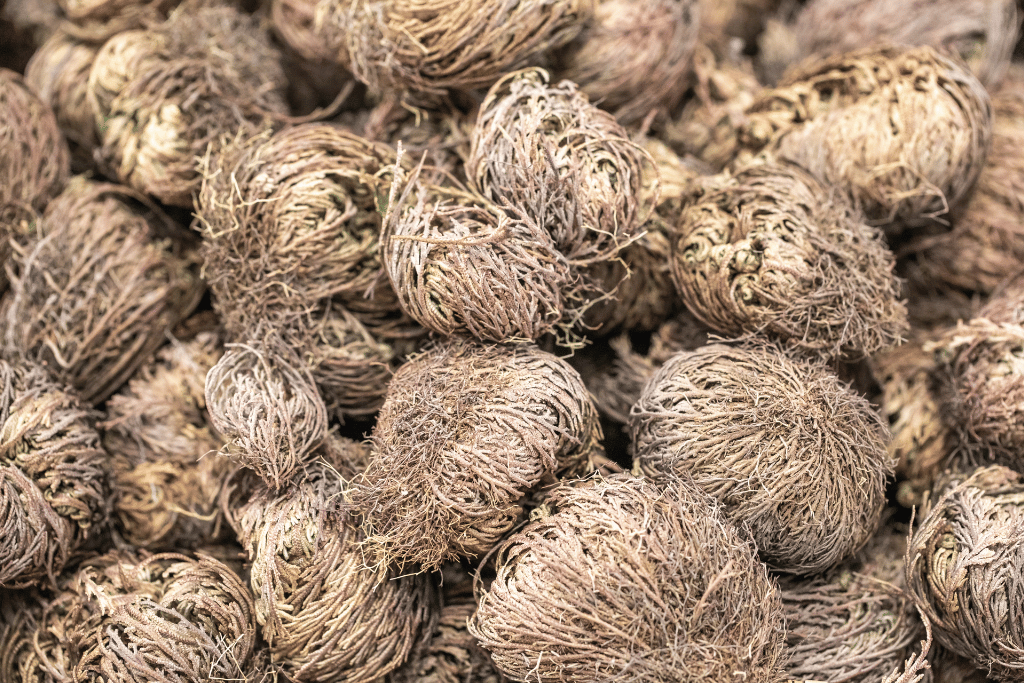
Top Tips
A quick recap of some fast facts to help you take the best care and get the most out of your rose of Jericho.
- Keep your rose of Jericho out of direct sun, but provide it with plenty of bright indirect light.
- Keep the air surrounding your resurrection plant at a medium to high humidity level. If the air is moist, you can worry less about providing water at the base of the plant.
- Don’t let your rose of Jericho sit in water for too long. Let the pebbles or medium dry out completely at least once a week.
- Fertilize a maximum of twice per year. Use a very diluted dose.
- Take cuttings from your rose of Jericho every spring and fall to promote new growth and propagate a bunch of new plants easily at no cost.
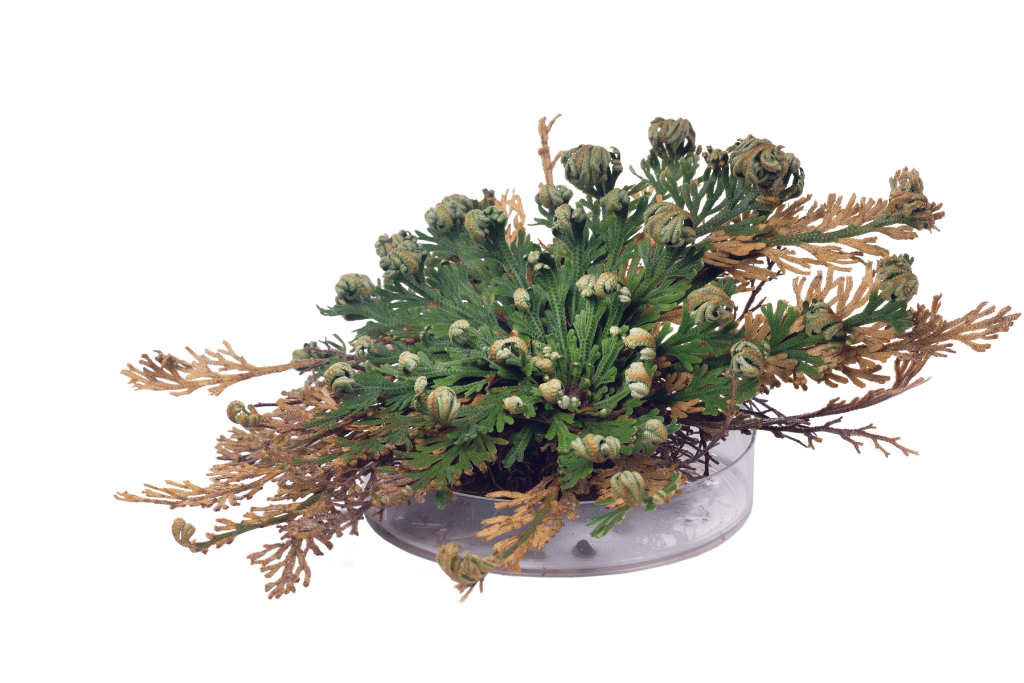
Frequently Asked Questions (FAQ)
How long does it take for a rose of Jericho to open?
After a desiccated rose of Jericho is exposed to water, it will open within a few hours. In 2-3 days’ time, it will be completely revived and full of lively green fronds.
Is the rose of Jericho plant the same as the resurrection plant?
There are actually two unrelated plants that both go by the rose of Jericho and the resurrection plant. Confusing, we know. Let’s break it down simply.
Selaginella lepidophylla is known as rose of Jericho plant or the “false” rose of Jericho. It is native to northern Mexico and the Southwestern United States. This is the more popular type that is commonly kept as a houseplant.
Anastatica hierochuntica is known as the “true” rose of Jericho plant. It is native to the Middle East.
Why won’t my rose of Jericho turn green?
If your rose of Jericho doesn’t unfold and return to a green shade when watered, unfortunately, it’s most likely dead. As tough as it is to kill one of these plants, wild swings in temperature, irregular periods of drought and overexposure to moisture can kill a rose of Jericho.


